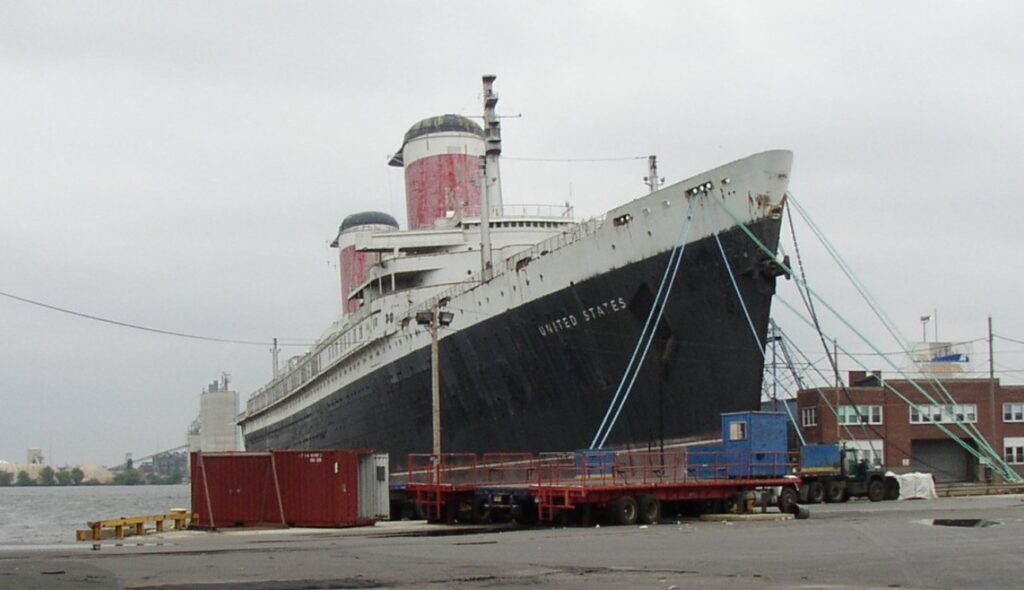The great ocean liners carried passengers across the Atlantic Ocean between Europe and America for nearly two centuries. These magnificent steam powered ships carried the rich and famous as well as immigrants seeking a new life. They competed against each other for the Blue Riband prize for the fastest Atlantic crossings. The golden age of purpose-built ocean liners was from about 1900 to the 1930’s. By the late 1960’s faster and more affordable Trans-Atlantic air travel led to the scrapping of most of the ocean liners. Today, the only ocean liner still in service is the Queen Mary 2.

In the 1950’s my mother took me to New York City and I was fortunate enough to be able to see one of the last great ocean liners, the SS United States. The ship was an incredible sight. She had a huge bow that towered over the water and her black hull and white trim stretched back 990 feet. The twin red stacks were swept back giving a hint to her great speed. Indeed, she was the most powerful ocean liner ever built. Unfortunately, this historic vessel, a symbol of America’s maritime heritage, will be sunk sometime next year off Destine, Florida to become the world’s largest artificial reef.
The SS United States was launched in 1951 and was the largest ocean liner ever built in the United States. She is 990 feet long with a beam of 101 feet, draws 31 feet and is 175 feet from her keel to the top of her funnel. She weighs 45,000 tons and her engines developed 240,000 horsepower. The ship was designed by American naval architect William Francis Gibbs. He wanted to design a grand American ship to surpass all others and his design incorporated many innovations in steam propulsion, hull form, fire safety, and damage control.
In 1945 the US Maritime Commission solicited designs for a ship that could act as a troop transport in time of war like the Queen Mary was in WWII. The ship’s size and speed meant she could rapidly deploy a 14-thousand-man division anywhere in the world without needing to refuel. Her speed also made her virtually immune to submarine attacks. Gibbs submitted the design for his grand American ship and won the contract. Her construction and cost of $78 million was shared by United States Navy and the United States Lines.
The SS United States is the fastest ocean liner to ever cross the Atlantic Ocean in either direction and in 1952 won the Blue Riband prize for the highest average speed across the Atlantic. The Navy kept the liner’s top speed a secret until later it was reported to be 44.10 mph, which she achieved during a full-power trial run on June 10, 1952. Compared to a modern cruise ship, which generally cruise at about 20 knots, she was twice as fast. It was reported at the time that the paint along her sides was worn off by her speed through the water.
The ship used the traditional three-tiered class system for passengers. Each class was segregated, having its own dining rooms, bars, public spaces, services, and recreation areas. At maximum capacity the United States could carry 894 first class, 524 cabin class, and 554 tourist-class passengers. The cost of a first-class ticket in today’s dollars started at $4,098 a cabin ticket $2,576, and a tourist ticket $1,932.
Between 1952 and 1969 the ship served as a US icon, transporting celebrities and immigrants throughout her career. Despite her record speed passenger counts declined in the mid-1960s due to the rise in fast, affordable transatlantic jet air travel making the grand ocean liner obsolete and unprofitable.
The SS United States was withdrawn from service in 1969 after the financial collapse of United States Lines. During the following years the ship changed hands many times. There were many efforts to repurpose her but the cost, estimated to be at least $700 million, was too high. Every new owner tried to make the ship profitable, but she was poorly maintained and aging fast. Her interior furnishings were sold at auction in 1984, and the rest of her interior was stripped in 1994. She was seized by US marshals and towed to Philadelphia in 1996 where she sat for thirty years.
Finally, last February the SS United States was purchased by Okaloosa County, Florida to be used as the world’s largest artificial reef about twenty miles off Destin and Fort Walton Beach, Florida. She was towed to Mobile, Alabama where she is being readied to be sunk in approximately 180 feet of water. The upper decks will be about 55-60 feet below the surface. This depth is accessible to beginner divers while also appealing to more experienced technical divers.
I have mixed feelings about the ship becoming an artificial reef. On the one hand she will be serving a purpose which beats being scrapped on a beach in India, to see this magnificent ship on the seafloor will surely be an amazing sight. On the other hand, I wish she could have been saved.
